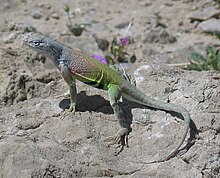Cophosaurus
Cophosaurus texanus є єдиним видом монотипного роду Cophosaurus. Він тісно пов'язаний з видами в роду Holbrookia, і фактично був поміщений у цей рід і згадувався як Holbrookia texana з 1852 року до 1970-х років[2][3][4][5]. У Cophosaurus відсутні зовнішні вушні отвори, пристосування до заривання в пісок, як і заглиблена нижня щелепа та розширена верхня губна луска. Cophosaurus є статево диморфними, самці стають більшими та барвистішими за самок, демонструючи рожевий і зелений кольори, які особливо яскраві в період розмноження. Дві жирні чорні смуги позначають бічну частину самців, але вони значно зменшені та розпливчасті, а іноді й зовсім відсутні у самиць[3][6][7].
| Cophosaurus | |
|---|---|

| |
| Cophosaurus texanus (самець) | |
| Біологічна класифікація | |
| Царство: | Тварини (Animalia) |
| Тип: | Хордові (Chordata) |
| Клас: | Плазуни (Reptilia) |
| Ряд: | Лускаті (Squamata) |
| Підряд: | Ігуаноподібні (Iguania) |
| Родина: | Phrynosomatidae |
| Рід: | Cophosaurus Troschel, 1852 |
| Вид: | C. texanus
|
| Біноміальна назва | |
| Cophosaurus texanus Troschel, 1852
| |
Cophosaurus є рідною для пустелі Чіуауа та інших посушливих і напівпосушливих регіонів південного заходу Сполучених Штатів і північної Мексики, де вони найчастіше займають помірно відкриті ділянки рідкісної рослинності з камінням, гравієм і піском[8] [9][10][11]. Загальне забарвлення окремих ящірок часто збігається з кольорами скель і ґрунтів місцевості, в якій вони мешкають. Вони часто покладаються на камуфляж і свою швидкість, щоб уникнути загроз і хижаків, перш ніж відступити в ущелини скель. Вони переважно комахоїдні, полюють на різноманітних цвіркунів, коників, гусениць, мурах, мух, жуків і жуків. Іноді також їдять павуків і дрібних ящірок[12][13]. Cophosaurus є яйцекладними. Самиці відкладають від 1 до 4 кладок по 2–9 яєць на рік, причому дитинчата виводяться з червня по жовтень і досягають дорослого розміру та статевої зрілості протягом одного року[14][11][14][15][16][12][17].
Примітки
ред.- ↑ Cophosaurus texanus (Greater Earless Lizard). Iucnredlist.org. Процитовано 26 січня 2012.
- ↑ Baird, Spencer F. and Charles F. Girard. 1852. Characteristics of some new reptiles in the Museum of the Smithsonian Institution, part 2. Proc. Acad. Nat. Sci. Philadelphia 6: 125-129. (page 125)
- ↑ а б Peters, James A. 1951. Studies on the lizard Holbrookia texana (Troschel) with descriptions of two new subspecies. Occasional Papers of the Museum of Zoology University of Michigan, (537): 1-20.
- ↑ Guttman, S. I. 1970. An electrophoretic study of the hemoglobins of the sand lizards, Callisaurus, Cophosaurus, Holbrookia, and Uma. Comparative Biochemistry and Physiology 34(3): 569-574.
- ↑ Cox, Douglas C. & Wilmer W. Tanner. 1977. Ostelolgy and Myology of the Head and Neck Regions of Callisaurus, Cophosaurus, Holbrookia, and Uma (Reptilia: Iguanidae). Great Basin Naturalist 37: 35-56.
- ↑ Howland, Jeffrey M. 2009. Greater Earless Lizard Cophosaurus texanus, Troschlel, 1852. pages 146-149 IN Lawrence L. C. Jones and Robert E. Lovich (editors). Lizards of the American Southwest, A Photographic Field Guide. Rio Nuevo Publishers. Tucson, Arizona. 567 pp. ISBN 1-933855-35-5
- ↑ Stebbins, Robert C. and Samuel M. McGinnis. 2018. Peterson Field Guide to Western Reptiles and Amphibians, 4th ed. Houghton Mifflin Harcourt Publidhing Co. New York, N.Y. xi, 560 pp. (pages 276-277) ISBN 9781328715500
- ↑ Farr, William L., David Lazcano, and Paablo A. Lavin-Murcio. 2013. New Distributional Records for Amphibians and Reptiles from the State of Tamaulipas, Mexico III. Herpetological Review 44(4): 631-645. (pages 634-635)
- ↑ Thomason, Libby. 2018. Cophosaurus texanus, Greater Earless Lizard. Animal Diversity Web. University of Michigan, Museum of Zoology. (accessed 22 June 2022)
- ↑ Axtell, Ralph W. 1991. Interpretive Atlas of Texas Lizards, No. 10, Cophosaurus texanus. Published by Ralph W. Axtell, Southern Illinois University at Edwardsville, Edwardsville, Illinois. 1-41 pp.
- ↑ а б Degenhardt, William G., Charles W. Painter, and Andrew H. Price. 1996. Amphibians and Reptiles of New Mexico. University of New Mexico Press, Albuquerque, New Mexico. xix, 431 pp. (pages 141-144) ISBN 0-8263-1695-6
- ↑ а б Smith, Donald D., Philip A. Medica, and Sherburn R. Sanborn. 1987. Ecological comparison of sympatric populations of sand lizards (Cophosaurus texanus and Callisaurus draconoides). Great Basin Naturalist, 47(2): 175-185.
- ↑ Maury, Ma Eugenia. 1995. Diet Composition of the Greater Earless Lizard (Cophosaurus texanus) in central Chihuahuan Desert. Journal of Herpetology, 29(2): 266-272.
- ↑ а б Johnson, Clifford 1960. Reproductive cycle in females of the greater earless lizard, Holbrookia texana. Copeia, 1960(4): 297-300.
- ↑ Ballinger, Royce E., Earl D. Tyler, and Donald W. Tinkle. 1972. Reproductive ecology of a west Texas population of the greater earless lizard, Cophosaurus texanus. The American Midland Naturalist, 88/2: 419-428.
- ↑ Schrank, Gordon D., and Royce E. Ballinger. 1973. Male reproductive cycles in two species of lizards (Cophosaurus texanus and Cnemidophorus gularis). Herpetologica, 29(3): 289-293.
- ↑ Sugg, Derrick W., Lee A. Fitzgerald, and Howard L. Snell. 1995. Growth rate, timing of reproduction, and size dimorphism in the southwestern earless lizard (Cophosaurus texanus scitulus). The Southwestern Naturalist, 40(2): 193-202.
